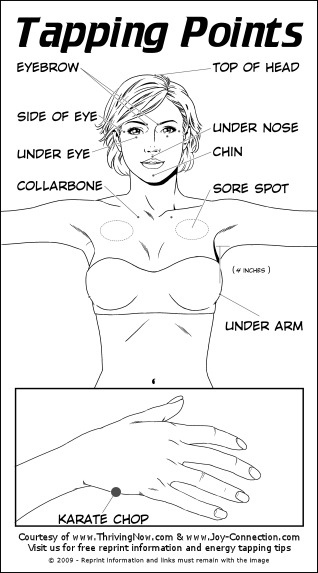Tapping therapy (also referred to as Emotional Freedom Technique) is one method I have discovered that not only addresses physical symptoms but can also help to sooth emotions and free you from persistent thought patterns. For instance, I have used it lately to support my sleep. I have been listening to Dawson Church’s audiobook “Meditations to Overcome Insomnia” and the skills I’ve learned have allowed me to find deep rest and help me flip the limiting belief that I have “insomnia”. It truly has been amazing, and I’m so happy to share this with you because this is a process with so many applications.
This alone would be worth celebrating but add the fact that it’s quite a simple method to learn and employ makes it an ace up the sleeve for any therapeutic tool kit
Tapping is an evidence-based tool that soothes big feelings in our body and can address anxiety, depression, fears and phobias, and yes even PTSD. So if you’re asking why try it? Well, what you can feel you can heal. And yes please do try this at home.
Tapping therapy combines principles from ancient Chinese acupressure and modern psychology. The technique involves tapping on specific points of the body while focusing on an emotional issue or physical discomfort. By doing so, it’s believed, and there’s an impressive growing body of academic research to supports its effectiveness, that the body’s energy system can be brought back into balance.
It employs the same meridian system as acupuncture, but without the use of needles, to release blocked energy that is stored in your nervous system and which can manifest as negative emotions, physical symptoms, or even negative beliefs about yourself and the world.
It’s good to just give it try. After just one round of tapping you may feel some relief from physical and emotional pain and a boosted sense of well-being. Ideally use the SUDS method (rating your pain on a scale of 1 to 10) prior to and then again after using it to give you an idea of how effective it has been.
To practice Tapping Therapy, one starts by acknowledging and connecting with the issue that we want to process. Whether it’s stress, anxiety, pain, or any other emotional or physical discomfort – try focusing on a memory, an emotion, a symptom or something that is coming up in the current moment.
To help you make this connection you use certain words or phrases. The language you use isn’t essential although it helps. Firstly, acknowledge that while you may be manifesting a certain pain or discomfort, you also acknowledge your ability to move through that; for example, “Even though I feel this pain in my shoulders I fully and completely accept myself”. If you find it challenging to say “I completely accept myself” feel free to drop those words. As stated, the words aren’t what’s important, it’s the freeing of the energy through the tapping sequence.
Repeat this phrase 3 times whilst tapping on what is known as the karate chop point, namely the edge of your palm below the little finger. Then, using your fingertips, tap on the designated meridian points on the face, upper body, under the arms and top of the head (see diagram) while repeating a phrase relating to the energy you want to shift, such as “This pain in my shoulders”.
Four Steps to Relief:
This process is repeated several times until a shift in emotions or physical sensations is experienced. If the feeling hasn’t shifted you can try again. Sometimes a few rounds may be necessary, especially for stubborn or old patterns. The steps below outline the method, but if you have never seen tapping used before, you might like to watch the video demonstration by Dawson Church below before trying them yourself.
STEP 1
Where in your body do you feel the emotional issue most strongly?
STEP 2
Determine the distress level in that place in your body on a scale of 0 to 10, where 10 is maximum intensity and 0 is no intensity.
STEP 3
The Setup: Repeat this statement three times, while continuously tapping the Karate Chop point on the side of the hand; “Even though I have (name the problem), I deeply and completely accept myself.”
STEP 4
The Tapping Sequence: Tap about 7 times on each of the energy points (see the diagram above), while repeating a brief phrase that reminds you of the problem.
Benefits of Tapping:
Stress Reduction: Tapping can help calm the nervous system, leading to reduced stress and anxiety.
Emotional Release: By tapping on specific points, individuals may experience the release of pent-up emotions, such as fear or anger, promoting emotional well-being.
Pain Management: Some find relief from physical pain through tapping, although results vary.
Empowerment: Tapping can empower individuals to take control of their emotional responses, fostering a sense of self-efficacy.
Limitations of Tapping:
Varied Effectiveness: While many report positive outcomes with tapping, it may not work for everyone or every issue, though it is encouraged that you at least try.
Requires Practice: Like any skill, mastering taping takes practice and may not yield immediate results.
Not a Substitute for Professional Help: Tapping complements but doesn’t replace professional therapy or medical treatment, especially for severe mental health conditions.
Safety Concerns: Some individuals may experience emotional distress when tapping on certain issues, emphasizing the need for caution and guidance.
Tapping is a simple yet profound way to address emotional and physical well-being. While it may give the impression of being a one-size-fits-all solution, it does have a wide range of applications and you may find it to be a valuable tool for your own self-care. As with any technique, it’s essential to approach tapping with an open mind, realistic expectations, and, honour your own wisdom, and when needed, seek support from a qualified professional.










Leave A Comment